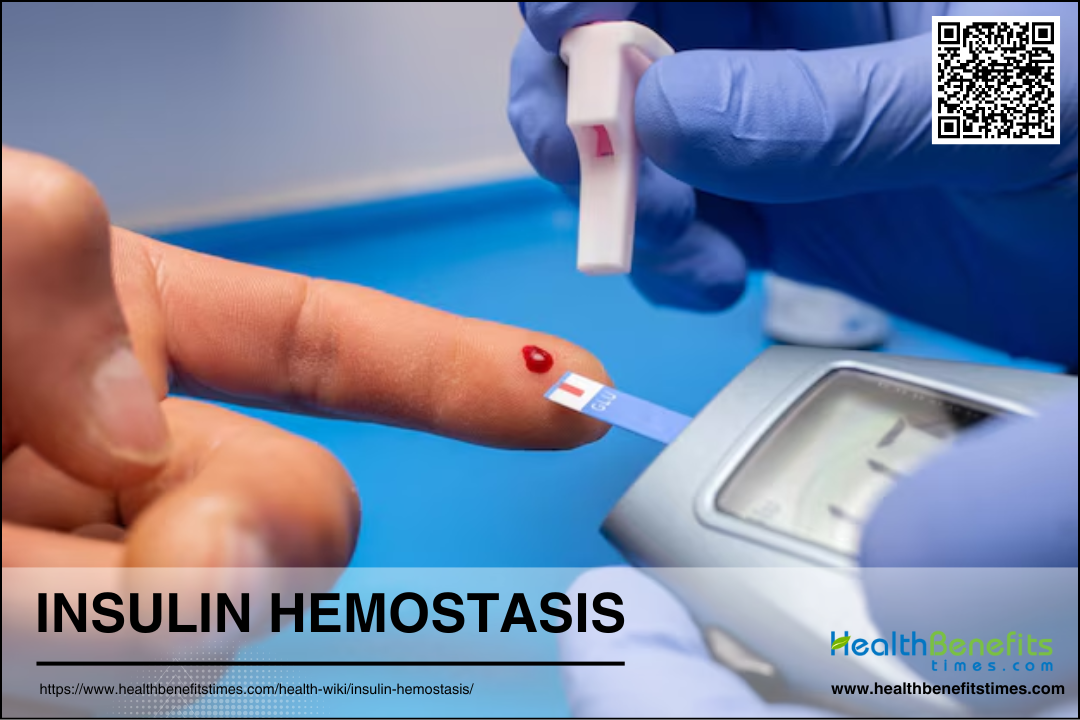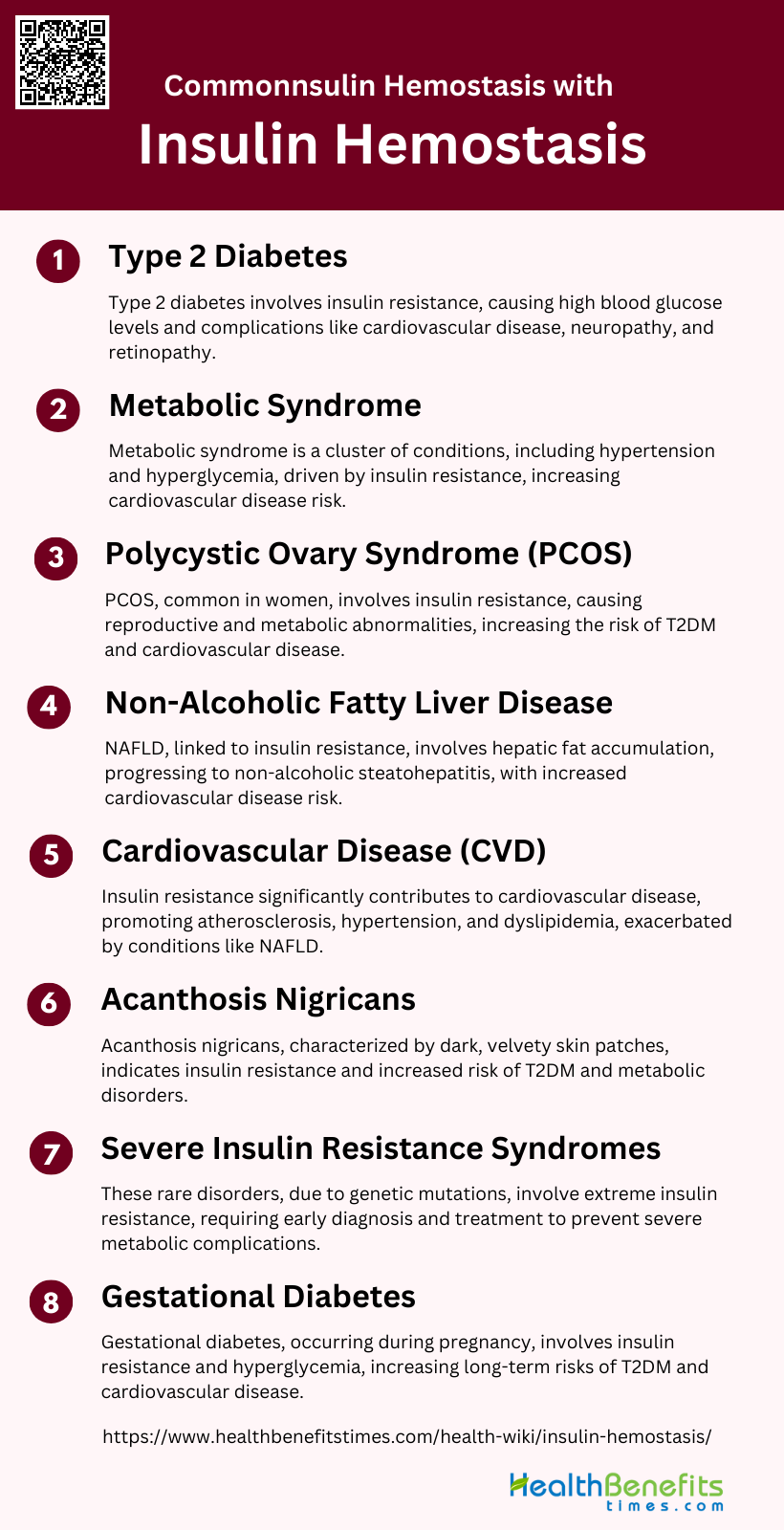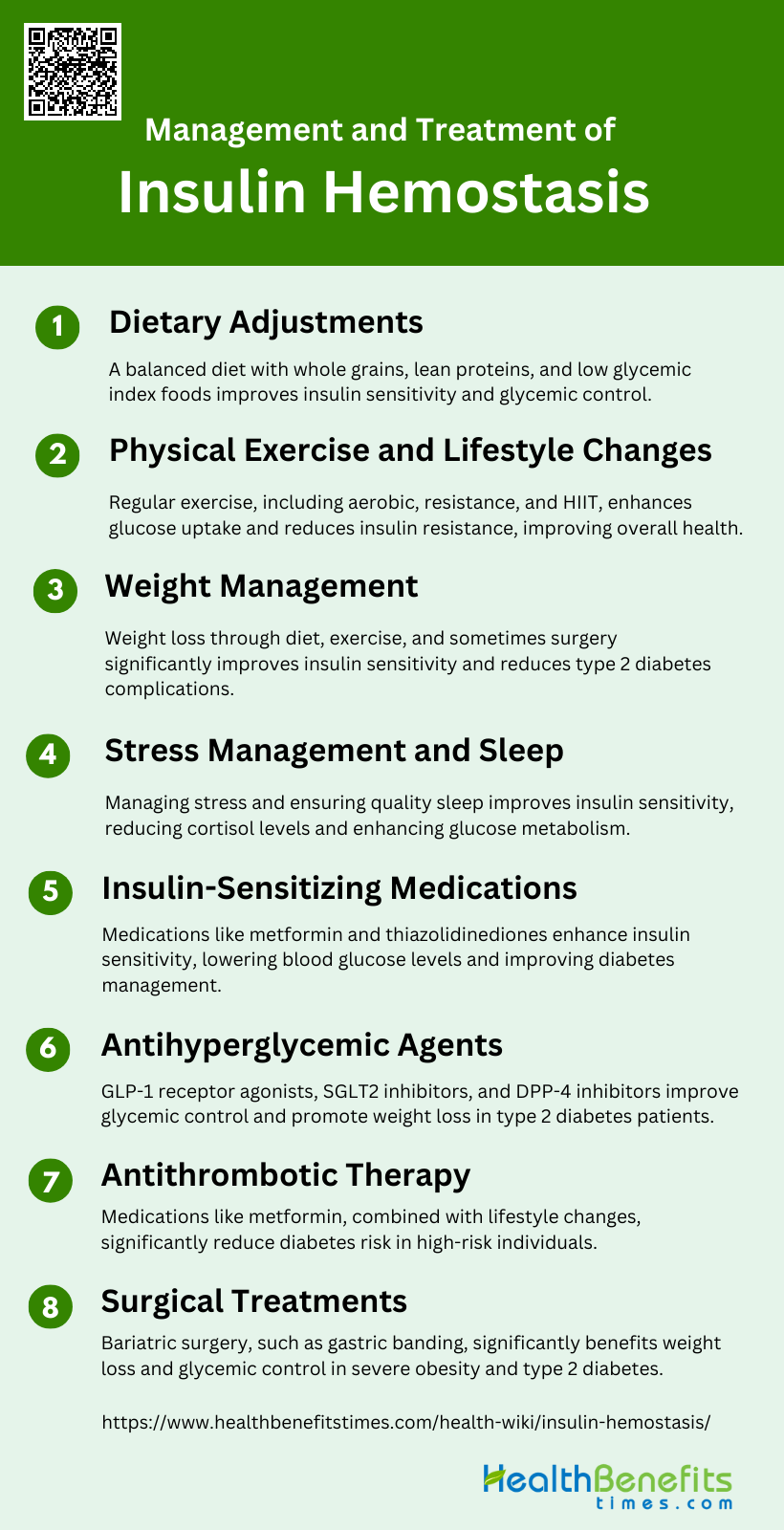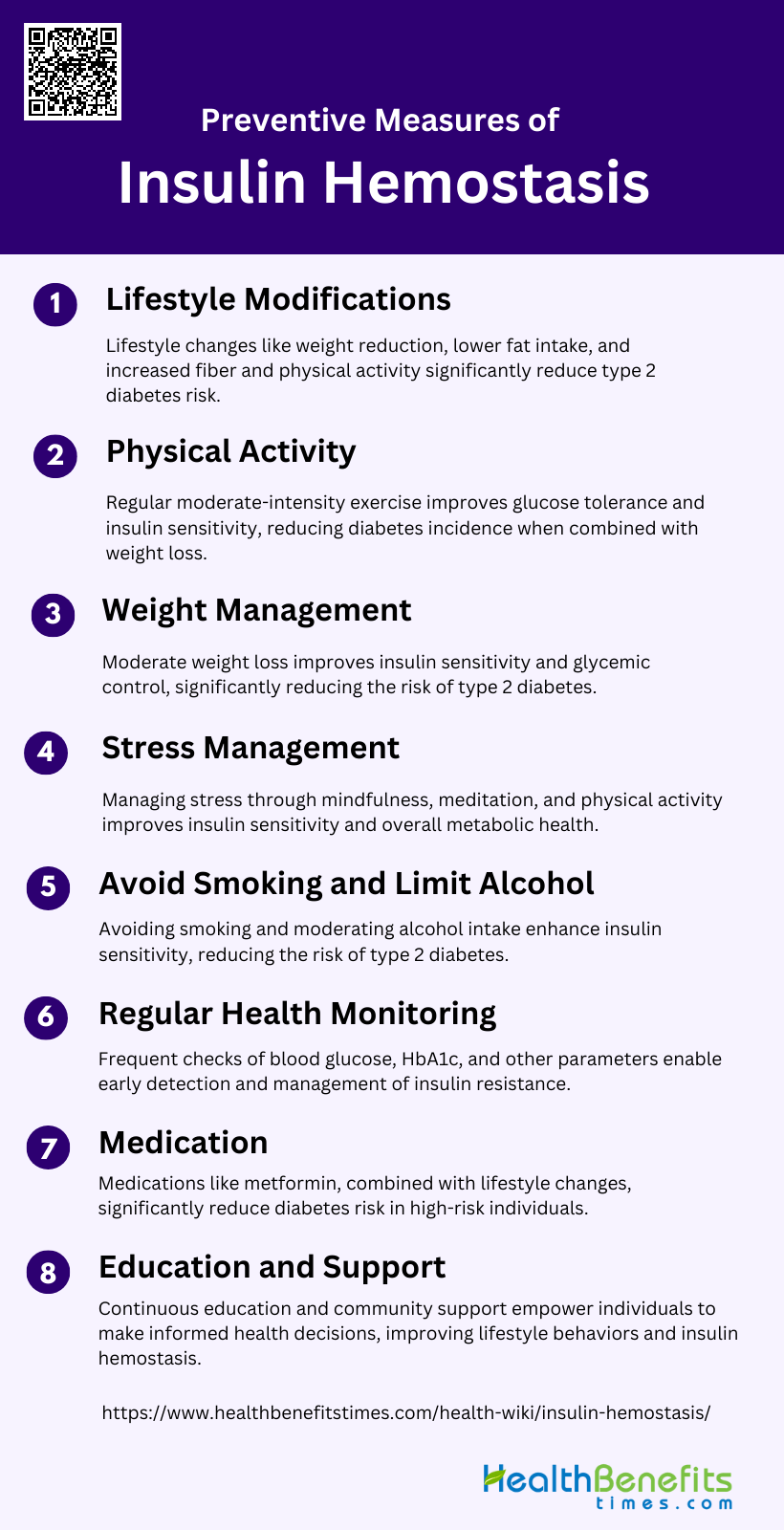Insulin hemostasis refers to the complex interplay between insulin and the body’s blood clotting mechanisms. Insulin, a hormone crucial for regulating blood glucose levels, also plays a significant role in maintaining the balance of hemostatic factors in the blood. Research has shown that insulin can influence various components of the hemostatic system, including platelet function, coagulation factors, and fibrinolysis. In individuals with insulin resistance or diabetes, this balance can be disrupted, leading to a prothrombotic state characterized by increased platelet reactivity, elevated levels of coagulation factors, and impaired fibrinolysis. This dysregulation of hemostasis in the context of insulin resistance contributes to the increased risk of cardiovascular complications observed in conditions such as metabolic syndrome and type 2 diabetes mellitus. Understanding the relationship between insulin and hemostasis is crucial for developing strategies to prevent and manage thrombotic complications in these patient populations.
How Insulin Hemostasis Works
It is a critical process that ensures the body’s glucose levels remain stable. This involves the regulation of insulin production, secretion, and action to maintain blood sugar within a narrow range. The following steps outline how this intricate system operates:
1. Insulin and Glucose Metabolism
It is secreted by the β-cells of the pancreas in response to elevated blood glucose levels, particularly after meals. Insulin facilitates the uptake of glucose by cells, especially in the liver, muscle, and adipose tissues, where it is either stored as glycogen or used for energy production. This hormone also inhibits gluconeogenesis and glycogenolysis in the liver, thereby reducing endogenous glucose production. Additionally, insulin influences the metabolism of lipids and proteins, promoting anabolic processes and inhibiting catabolic ones. The intricate balance between insulin and other hormones like glucagon is essential for maintaining metabolic homeostasis.
2. Role in Regulating Blood Sugar Levels
After food intake, insulin is released to promote glucose uptake by peripheral tissues, thereby lowering blood glucose levels. It also suppresses hepatic glucose production, ensuring that blood sugar levels do not spike excessively. During fasting or between meals, insulin levels drop, allowing glucagon to stimulate glucose release from the liver to maintain normoglycemia. Disruptions in insulin signaling, such as insulin resistance, can lead to chronic conditions like type 2 diabetes, where the body fails to regulate blood sugar levels effectively Understanding these mechanisms is crucial for developing therapeutic strategies to manage diabetes and other metabolic disorders.
The process of maintaining insulin hemostasis balance
The process of maintaining insulin homeostasis balance is a complex interplay involving multiple hormones and physiological mechanisms. Insulin, secreted by the beta cells of the pancreas in response to elevated blood glucose levels, plays a crucial role in promoting glucose uptake by tissues such as skeletal muscle and adipose tissue, while inhibiting glucose production in the liver. This balance is further modulated by glucagon, which is secreted by alpha cells in the pancreas when blood glucose levels fall, stimulating glucose production and release from the liver. Additionally, insulin influences lipid and protein metabolism, contributing to overall energy homeostasis. The intricate regulation of insulin and glucagon ensures that blood glucose levels remain within a narrow physiological range, preventing conditions such as hypoglycemia and hyperglycemia. Understanding these mechanisms is essential for developing therapeutic strategies for diabetes mellitus, where insulin secretion or action is impaired.
Factors influencing insulin hemostasis
Insulin homeostasis is influenced by a variety of factors, including hemostatic variables, sex hormones, and the gut microbiome. Hemostatic factors such as fibrinogen, factor VII, and plasminogen activator inhibitor-1 (PAI-1) have been shown to correlate with insulin resistance and the development of diabetes. For instance, higher levels of PAI-1 and factor VII are associated with increased insulin resistance and diabetes risk, particularly in women. Additionally, sex hormones like testosterone and sex hormone-binding globulin (SHBG) modify the relationship between hemostatic factors and insulin resistance, with lower SHBG levels linked to higher PAI-1 and greater insulin resistance. The gut microbiome also plays a crucial role in insulin regulation by processing nutrients and generating metabolites that influence insulin secretion and sensitivity. Gut-derived bacterial factors can either promote insulin resistance or act as insulin sensitizers, highlighting the complex interplay between the gut microbiome and insulin homeostasis. Understanding these multifaceted interactions is essential for developing targeted interventions for metabolic diseases such as type 2 diabetes.
Common Disorders Associated with Insulin Hemostasis
Insulin hemostasis is crucial for maintaining balanced blood sugar levels, and disruptions in this process can lead to various health issues. These disorders can significantly impact an individual’s quality of life and require careful management. The following are some common disorders associated with insulin hemostasis:
1. Type 2 Diabetes
Type 2 diabetes mellitus (T2DM) is closely linked with insulin resistance, a condition where the body’s cells become less responsive to insulin. This resistance leads to elevated blood glucose levels, which over time can cause various complications such as cardiovascular disease, neuropathy, and retinopathy. Insulin resistance is a common feature in metabolic disorders, including non-alcoholic fatty liver disease (NAFLD) and metabolic syndrome, which often coexist with T2DM. The bidirectional relationship between NAFLD and T2DM highlights the importance of managing insulin resistance to prevent the progression of both conditions.
2. Metabolic Syndrome
Metabolic syndrome (MetS) is a cluster of conditions, including hypertension, hyperglycemia, dyslipidemia, and central obesity, that increase the risk of cardiovascular disease and T2DM. Insulin resistance is a central feature of MetS, contributing to the development of NAFLD and other metabolic disorders. The interplay between insulin resistance and MetS exacerbates the risk of cardiovascular complications, making it crucial to address lifestyle factors such as diet and physical activity to improve insulin sensitivity and reduce the incidence of MetS.
3. Polycystic Ovary Syndrome (PCOS)
Polycystic ovary syndrome (PCOS) is a common endocrine disorder in women, characterized by hyperandrogenism, ovulatory dysfunction, and polycystic ovaries. Insulin resistance is prevalent in PCOS, independent of obesity, and contributes to the metabolic and reproductive abnormalities observed in affected women. The coexistence of PCOS and NAFLD further increases the risk of T2DM and cardiovascular disease, emphasizing the need for early diagnosis and management of insulin resistance in PCOS patients.
4. Non-Alcoholic Fatty Liver Disease (NAFLD)
NAFLD is the most common chronic liver disease worldwide, strongly associated with insulin resistance and metabolic syndrome. Insulin resistance promotes hepatic fat accumulation, leading to NAFLD and its progression to non-alcoholic steatohepatitis (NASH). The relationship between NAFLD and insulin resistance is bidirectional, with each condition exacerbating the other. Effective management of insulin resistance is essential to prevent the progression of NAFLD and its associated complications, including cardiovascular disease.
5. Cardiovascular Disease (CVD)
Cardiovascular disease (CVD) is a leading cause of morbidity and mortality globally, with insulin resistance being a significant risk factor. Insulin resistance contributes to the development of atherosclerosis, hypertension, and dyslipidemia, all of which are key components of CVD. The presence of NAFLD further increases cardiovascular risk, highlighting the importance of addressing insulin resistance to reduce the burden of CVD. Lifestyle modifications and pharmacological interventions targeting insulin resistance can significantly improve cardiovascular outcomes.
6. Acanthosis Nigricans
Acanthosis nigricans is a skin condition characterized by dark, velvety patches, often associated with insulin resistance. It is commonly observed in individuals with obesity, PCOS, and metabolic syndrome. The condition serves as a clinical marker of hyperinsulinemia and insulin resistance, indicating an increased risk of developing T2DM and other metabolic disorders. Addressing the underlying insulin resistance through lifestyle changes and medical treatment can improve acanthosis nigricans and reduce the risk of associated metabolic complications.
7. Severe Insulin Resistance Syndromes
Severe insulin resistance syndromes encompass a group of rare disorders characterized by extreme insulin resistance, often due to genetic mutations affecting insulin signaling pathways. These syndromes can present with features such as hyperandrogenism, acanthosis nigricans, and severe metabolic disturbances. Management of these conditions involves addressing the underlying genetic defects and improving insulin sensitivity through pharmacological and lifestyle interventions. Early diagnosis and treatment are crucial to prevent long-term complications associated with severe insulin resistance.
8. Gestational Diabetes
Gestational diabetes mellitus (GDM) is a form of diabetes that occurs during pregnancy, characterized by insulin resistance and hyperglycemia. Women with GDM are at increased risk of developing T2DM and cardiovascular disease later in life. Insulin resistance during pregnancy can lead to adverse outcomes for both the mother and the fetus, including preeclampsia, macrosomia, and neonatal hypoglycemia. Effective management of GDM through dietary modifications, physical activity, and pharmacotherapy is essential to mitigate these risks and improve maternal and fetal health outcomes.
Symptoms of Insulin Hemostasis
When this balance is disrupted, it can lead to various symptoms that may indicate underlying health issues. Recognizing these symptoms early can help in managing and treating potential disorders. The following are common symptoms associated with insulin hemostasis:
- Increased thirst and frequent urination
- Fatigue and weakness
- Blurred vision
- Slow wound healing
- Unexplained weight loss or gain
- Numbness or tingling in hands or feet
- Recurrent infections
- In women, irregular menstrual cycles and fertility issues
Diagnosis of Insulin hemostasis
Diagnosing issues with insulin hemostasis involves a series of tests and evaluations to assess how well the body is managing blood sugar levels. These diagnostic methods help identify potential disorders such as diabetes or insulin resistance. The following are key steps in the diagnosis of insulin hemostasis:
1. Blood Tests
Blood tests are fundamental in diagnosing insulin homeostasis and related disorders. The Homeostasis Model Assessment (HOMA) is a widely used method to evaluate insulin resistance and β-cell function from fasting plasma glucose and insulin concentrations. Studies have shown that HOMA is a reliable surrogate measure of in vivo insulin sensitivity, correlating well with the glucose clamp technique, which is considered the gold standard. Additionally, glycated hemoglobin (HbA1c) and fasting insulin levels are useful markers. HbA1c is commonly used to diagnose diabetes mellitus and can help in understanding the metabolic syndrome and profiling patients. Fasting glucose and insulin levels, along with HOMA, are also effective in identifying insulin resistance in various populations, including obese children and adolescents.
2. Additional Assessments
Additional assessments such as the oral glucose tolerance test (OGTT) provide valuable information on insulin sensitivity and glucose metabolism. The OGTT involves measuring blood glucose and insulin levels at multiple intervals after oral glucose administration, offering a dynamic view of glucose handling by the body. This test is particularly useful in pediatric populations to validate simple fasting methods like HOMA, fasting glucose/insulin ratio (FGIR), and quantitative insulin sensitivity check index (QUICKI). Moreover, the insulin hypoglycemia test (IHT) can identify individuals at risk for hypoglycemia failure, with HOMA values helping to predict the likelihood of achieving adequate hypoglycemia6. These assessments complement fasting blood tests and provide a comprehensive evaluation of insulin homeostasis.
3. Specialized Tests
Specialized tests such as the 72-hour fasting test are crucial for diagnosing specific conditions like insulinoma. This test involves frequent assessment of glucose, insulin, and C-peptide levels in venous blood, with the Homeostasis Model Assessment of β-cell function (HOMA-B) calculated at the end of the fasting period. HOMA-B has shown high diagnostic sensitivity and specificity for insulinoma, making it a precise tool for diagnosis. Additionally, the product of fasting glucose and triglycerides (TyG index) has been proposed as a surrogate for estimating insulin resistance, especially in resource-limited settings where insulin tests may not be readily available. These specialized tests provide targeted insights into specific disorders of insulin homeostasis, enhancing diagnostic accuracy and patient management.
Management and Treatment of Insulin hemostasis
Effective management and treatment of insulin hemostasis are essential to maintaining balanced blood sugar levels and preventing complications. This involves a combination of lifestyle changes, medications, and regular monitoring. The following steps outline key strategies for managing and treating insulin hemostasis:
1. Dietary Adjustments
Dietary adjustments play a crucial role in managing insulin hemostasis. A balanced diet rich in whole grains, lean proteins, healthy fats, and fiber can improve insulin sensitivity and glycemic control. Reducing the intake of refined sugars and processed foods helps in maintaining stable blood glucose levels. Studies have shown that dietary changes, such as incorporating low glycemic index foods, can significantly reduce HbA1c levels and improve overall metabolic health in individuals with type 2 diabetes. Additionally, weight loss achieved through dietary modifications can further enhance insulin sensitivity and reduce the risk of diabetes-related complications.
2. Physical Exercise and Lifestyle Changes
Regular physical exercise and lifestyle changes are essential for improving insulin sensitivity and managing blood glucose levels. Engaging in aerobic exercises, resistance training, and high-intensity interval training (HIIT) can enhance glucose uptake by muscles and reduce insulin resistance. A study demonstrated that lifestyle interventions, including exercise, significantly improved coagulation profiles and reduced prothrombotic states in individuals at high risk for type 2 diabetes. Moreover, combining physical activity with dietary adjustments can lead to better glycemic control and overall health outcomes.
3. Weight Management
Weight management is a critical component in the treatment of insulin hemostasis. Obesity is a major risk factor for insulin resistance and type 2 diabetes. Modest weight loss (5-10%) can lead to significant improvements in insulin sensitivity and glycemic control. Various strategies, including dietary changes, physical activity, and behavioral therapy, are employed to achieve and maintain weight loss. In some cases, pharmacologic therapy and metabolic surgery, such as laparoscopic adjustable gastric banding (LAGB), are considered for patients with severe obesity and type 2 diabetes, showing similar benefits in glycemic control and weight loss compared to intensive medical management programs.
4. Stress Management and Sleep
Effective stress management and adequate sleep are vital for maintaining insulin hemostasis. Chronic stress and poor sleep quality can lead to increased cortisol levels, which negatively impact insulin sensitivity and glucose metabolism. Implementing stress-reducing techniques such as mindfulness, meditation, and yoga can improve insulin sensitivity and glycemic control. Additionally, ensuring 7-9 hours of quality sleep per night is crucial for optimal metabolic function. Addressing sleep disorders and promoting good sleep hygiene can further enhance the management of insulin hemostasis.
5. Insulin-Sensitizing Medications
Insulin-sensitizing medications, such as metformin and thiazolidinediones, are commonly used to improve insulin sensitivity in patients with type 2 diabetes. These medications help lower blood glucose levels by enhancing the body’s response to insulin. Metformin, in particular, is often the first-line treatment due to its efficacy, safety profile, and weight-neutral effects. Thiazolidinediones, while effective, are associated with weight gain and other side effects, necessitating careful patient selection and monitoring. The choice of insulin-sensitizing medication should be individualized based on patient characteristics and treatment goals.
6. Antihyperglycemic Agents
Antihyperglycemic agents, including GLP-1 receptor agonists, SGLT2 inhibitors, and DPP-4 inhibitors, are used to manage blood glucose levels in patients with type 2 diabetes. These agents can be added to existing treatment regimens to achieve better glycemic control. GLP-1 receptor agonists and SGLT2 inhibitors have the added benefit of promoting weight loss, making them suitable for overweight or obese patients. However, the risk of hypoglycemia and other side effects should be considered when selecting antihyperglycemic agents.
7. Antithrombotic Therapy
Antithrombotic therapy is important for patients with type 2 diabetes who are at increased risk of arterial and venous thrombosis due to a prothrombotic state. Lifestyle interventions, including weight loss and improved insulin sensitivity, can reduce coagulation factor activities and improve hemostasis parameters. In addition to lifestyle changes, antithrombotic medications such as aspirin and anticoagulants may be prescribed to prevent thrombotic events. The choice of antithrombotic therapy should be based on individual risk factors and clinical guidelines.
8. Surgical Treatments
Surgical treatments, such as bariatric surgery, are considered for patients with severe obesity and type 2 diabetes who do not achieve adequate glycemic control with lifestyle and pharmacologic interventions. Procedures like laparoscopic adjustable gastric banding (LAGB) have shown significant benefits in weight loss and glycemic control. These surgical options can lead to long-term remission of diabetes and improvement in metabolic health. However, the decision to undergo surgery should be made after careful evaluation of the patient’s overall health, potential risks, and expected benefits.
Preventive measures of Insulin hemostasis
Maintaining insulin hemostasis is essential for preventing metabolic disorders such as diabetes and insulin resistance. Adopting healthy lifestyle habits can significantly contribute to the regulation of insulin levels and overall metabolic health. The following are key preventive measures for maintaining insulin hemostasis:
1. Lifestyle Modifications
Lifestyle modifications are fundamental in preventing insulin resistance and maintaining glucose homeostasis. Studies have shown that individualized counseling aimed at reducing weight, total fat intake, and increasing fiber and physical activity can significantly reduce the risk of developing type 2 diabetes. The Finnish Diabetes Prevention Study demonstrated that intensive lifestyle interventions led to long-term beneficial changes in diet, physical activity, and clinical parameters, reducing diabetes risk by 58%. These findings underscore the importance of adopting a healthy lifestyle to prevent insulin resistance and maintain glucose homeostasis.
2. Physical Activity
Regular physical activity is crucial for improving insulin sensitivity and glucose metabolism. A study comparing different intensities of exercise found that moderate-intensity exercise significantly improved glucose tolerance and insulin sensitivity, nearly as effectively as a combined approach involving diet and exercise. Additionally, the Diabetes Prevention Program (DPP) highlighted that 150 minutes of physical activity per week, combined with weight loss, reduced diabetes incidence by 58%. These results emphasize the role of consistent physical activity in maintaining insulin homeostasis and preventing diabetes.
3. Weight Management
Effective weight management is a key strategy in preventing insulin resistance and type 2 diabetes. Research indicates that even moderate weight loss can significantly improve insulin sensitivity and glycemic control. The DPP and other studies have shown that a 7% reduction in body weight, combined with increased physical activity, can lead to substantial reductions in diabetes risk. These findings highlight the importance of weight management in maintaining insulin homeostasis and preventing the progression to diabetes.
4. Stress Management
Managing stress is essential for maintaining insulin homeostasis, as chronic stress can lead to increased cortisol levels, which negatively impact insulin sensitivity. While specific studies on stress management and insulin homeostasis are limited, general health guidelines suggest that stress reduction techniques such as mindfulness, meditation, and regular physical activity can help improve overall metabolic health. Incorporating stress management strategies into daily routines can thus play a supportive role in maintaining insulin sensitivity and preventing diabetes.
5. Avoid Smoking and Limit Alcohol
Avoiding smoking and limiting alcohol intake are important preventive measures for maintaining insulin homeostasis. Smoking has been associated with increased insulin resistance and a higher risk of developing type 2 diabetes. Similarly, excessive alcohol consumption can lead to weight gain and metabolic disturbances, further impairing insulin sensitivity. Adopting a lifestyle that avoids smoking and moderates alcohol intake can therefore contribute to better insulin regulation and reduced diabetes risk.
6. Regular Health Monitoring
Regular health monitoring, including frequent checks of blood glucose levels, HbA1c, and other metabolic parameters, is crucial for early detection and management of insulin resistance. Studies have shown that early weight and glucose measurements can predict lower subsequent diabetes risk, allowing for timely interventions. Regular health monitoring enables individuals to track their progress and make necessary adjustments to their lifestyle and treatment plans, thereby maintaining insulin homeostasis and preventing diabetes.
7. Medication
In some cases, medication may be necessary to maintain insulin homeostasis and prevent the progression to diabetes. Metformin, for example, has been shown to significantly reduce the incidence of diabetes in individuals with impaired glucose tolerance. The Indian Diabetes Prevention Programme demonstrated that metformin, combined with lifestyle modifications, effectively reduced diabetes risk in high-risk populations. Medication, when prescribed by a healthcare professional, can thus be an important component of a comprehensive strategy to maintain insulin homeostasis.
8. Education and Support
Education and support are vital for empowering individuals to make informed decisions about their health and adopt preventive measures for insulin homeostasis. Community-level educational interventions have been shown to improve lifestyle behaviors, such as diet and physical activity, leading to better control of diabetes and hypertension. Providing continuous education and support helps individuals understand the importance of lifestyle modifications and adhere to recommended preventive measures, ultimately maintaining insulin homeostasis and reducing diabetes risk.





